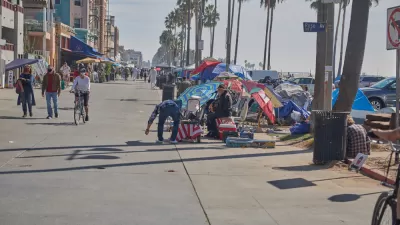The mortality rate among people experiencing homelessness jumped by 203 percent between 2011 and 2020.

A study of mortality rates among unhoused people reveals that the death rate tripled between 2011 and 2020 — even before the pandemic struck. Mariska Kendall explains the study’s results in Governing, writing: “Overdoses played a major role in the deaths studied. But people also are dying at increased rates of things that might be avoided if they had a home or regular access to preventative medical care, such as heat and cold exposure, traffic injuries, cardiovascular disease and diabetes.” Deaths from cardiovascular disease rose by 172 percent.
The researchers attribute the 283 percent increase in part to the opioid crisis, law enforcement crackdowns on encampments that force people to move to more isolated and unsafe locations, and the increase in the average age of unhoused people. “The number of Californians 55 and older who sought homelessness services soared 84 percent between 2017 and 2021, according to the state’s Homeless Data Integration System.”
Margot Kushel, director of the UCSF Benioff Homelessness and Housing Initiative, says becoming homeless is “incredibly bad for your health.” According to Kushel, “There is increasing evidence that you can prevent a lot of these deaths just by getting people housed.”
FULL STORY: It’s Become Significantly More Deadly to Be Homeless

Alabama: Trump Terminates Settlements for Black Communities Harmed By Raw Sewage
Trump deemed the landmark civil rights agreement “illegal DEI and environmental justice policy.”

Study: Maui’s Plan to Convert Vacation Rentals to Long-Term Housing Could Cause Nearly $1 Billion Economic Loss
The plan would reduce visitor accommodation by 25% resulting in 1,900 jobs lost.

Why Should We Subsidize Public Transportation?
Many public transit agencies face financial stress due to rising costs, declining fare revenue, and declining subsidies. Transit advocates must provide a strong business case for increasing public transit funding.

Paris Bike Boom Leads to Steep Drop in Air Pollution
The French city’s air quality has improved dramatically in the past 20 years, coinciding with a growth in cycling.

Why Housing Costs More to Build in California Than in Texas
Hard costs like labor and materials combined with ‘soft’ costs such as permitting make building in the San Francisco Bay Area almost three times as costly as in Texas cities.

San Diego County Sees a Rise in Urban Coyotes
San Diego County experiences a rise in urban coyotes, as sightings become prevalent throughout its urban neighbourhoods and surrounding areas.
Urban Design for Planners 1: Software Tools
This six-course series explores essential urban design concepts using open source software and equips planners with the tools they need to participate fully in the urban design process.
Planning for Universal Design
Learn the tools for implementing Universal Design in planning regulations.
Smith Gee Studio
Alamo Area Metropolitan Planning Organization
City of Santa Clarita
Institute for Housing and Urban Development Studies (IHS)
City of Grandview
Harvard GSD Executive Education
Toledo-Lucas County Plan Commissions
Salt Lake City
NYU Wagner Graduate School of Public Service





























